Analyzing Organizational Behavior: Culture, Motivation, and Teams
VerifiedAdded on 2023/06/05
|15
|4543
|86
Report
AI Summary
This report delves into the multifaceted realm of organizational behavior, examining how organizational culture, politics, and power dynamics impact individual and team performance. The analysis uses Mark and Spencer as a case study to illustrate these concepts. The report evaluates content and process theories of motivation, including Maslow's Hierarchy of Needs and Herzberg's Two-Factor Theory, and how motivational techniques enable effective goal achievement. Furthermore, the report differentiates between effective and ineffective teams, identifying key characteristics and applying concepts of organizational behavior within a practical business context. The application of Path-Goal theory is also explored, providing a comprehensive overview of organizational behavior principles and their practical implications.

Organizational
behaviour
behaviour
Paraphrase This Document
Need a fresh take? Get an instant paraphrase of this document with our AI Paraphraser
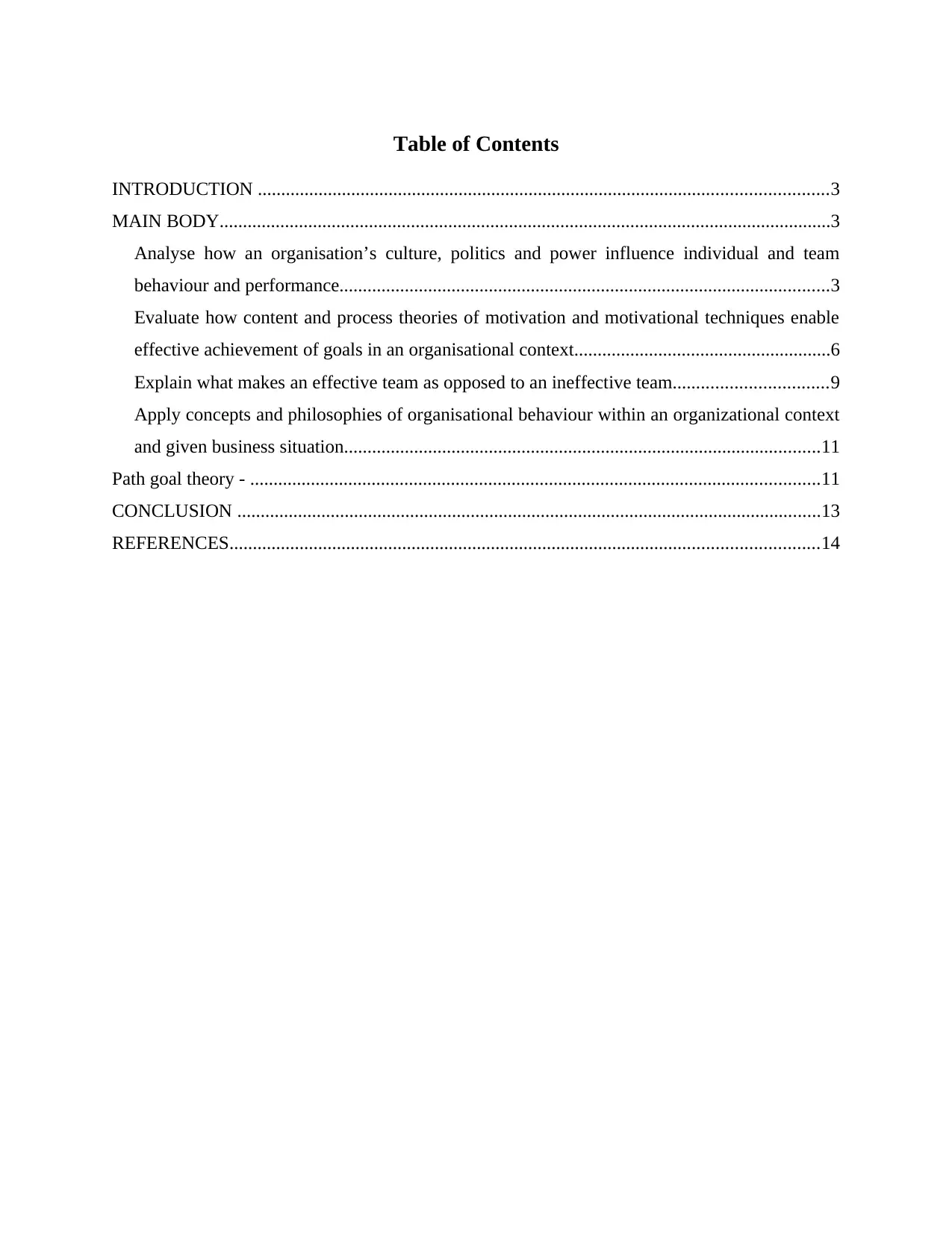
Table of Contents
INTRODUCTION ..........................................................................................................................3
MAIN BODY...................................................................................................................................3
Analyse how an organisation’s culture, politics and power influence individual and team
behaviour and performance.........................................................................................................3
Evaluate how content and process theories of motivation and motivational techniques enable
effective achievement of goals in an organisational context.......................................................6
Explain what makes an effective team as opposed to an ineffective team.................................9
Apply concepts and philosophies of organisational behaviour within an organizational context
and given business situation......................................................................................................11
Path goal theory - ..........................................................................................................................11
CONCLUSION .............................................................................................................................13
REFERENCES..............................................................................................................................14
INTRODUCTION ..........................................................................................................................3
MAIN BODY...................................................................................................................................3
Analyse how an organisation’s culture, politics and power influence individual and team
behaviour and performance.........................................................................................................3
Evaluate how content and process theories of motivation and motivational techniques enable
effective achievement of goals in an organisational context.......................................................6
Explain what makes an effective team as opposed to an ineffective team.................................9
Apply concepts and philosophies of organisational behaviour within an organizational context
and given business situation......................................................................................................11
Path goal theory - ..........................................................................................................................11
CONCLUSION .............................................................................................................................13
REFERENCES..............................................................................................................................14
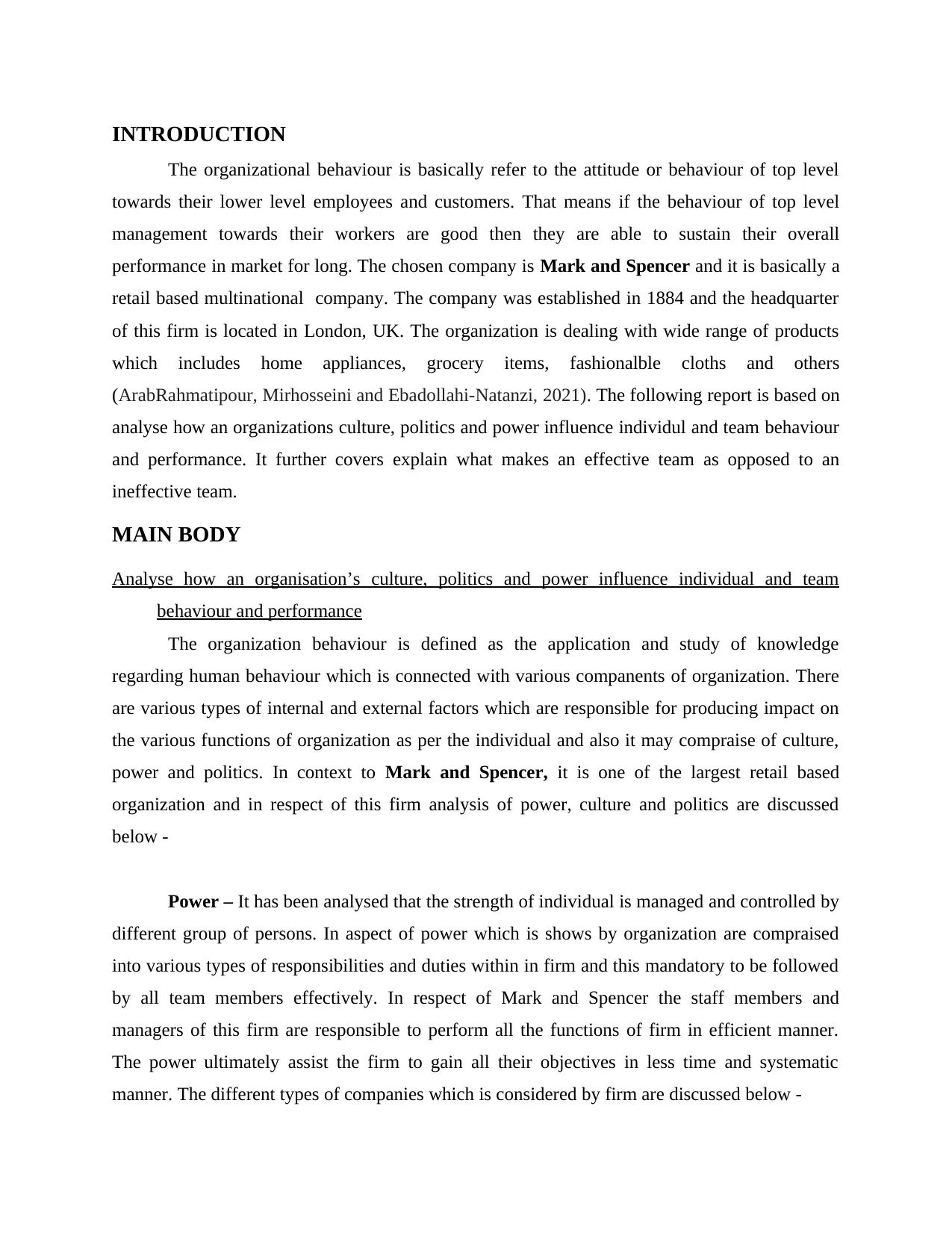
INTRODUCTION
The organizational behaviour is basically refer to the attitude or behaviour of top level
towards their lower level employees and customers. That means if the behaviour of top level
management towards their workers are good then they are able to sustain their overall
performance in market for long. The chosen company is Mark and Spencer and it is basically a
retail based multinational company. The company was established in 1884 and the headquarter
of this firm is located in London, UK. The organization is dealing with wide range of products
which includes home appliances, grocery items, fashionalble cloths and others
(ArabRahmatipour, Mirhosseini and Ebadollahi-Natanzi, 2021). The following report is based on
analyse how an organizations culture, politics and power influence individul and team behaviour
and performance. It further covers explain what makes an effective team as opposed to an
ineffective team.
MAIN BODY
Analyse how an organisation’s culture, politics and power influence individual and team
behaviour and performance
The organization behaviour is defined as the application and study of knowledge
regarding human behaviour which is connected with various companents of organization. There
are various types of internal and external factors which are responsible for producing impact on
the various functions of organization as per the individual and also it may compraise of culture,
power and politics. In context to Mark and Spencer, it is one of the largest retail based
organization and in respect of this firm analysis of power, culture and politics are discussed
below -
Power – It has been analysed that the strength of individual is managed and controlled by
different group of persons. In aspect of power which is shows by organization are compraised
into various types of responsibilities and duties within in firm and this mandatory to be followed
by all team members effectively. In respect of Mark and Spencer the staff members and
managers of this firm are responsible to perform all the functions of firm in efficient manner.
The power ultimately assist the firm to gain all their objectives in less time and systematic
manner. The different types of companies which is considered by firm are discussed below -
The organizational behaviour is basically refer to the attitude or behaviour of top level
towards their lower level employees and customers. That means if the behaviour of top level
management towards their workers are good then they are able to sustain their overall
performance in market for long. The chosen company is Mark and Spencer and it is basically a
retail based multinational company. The company was established in 1884 and the headquarter
of this firm is located in London, UK. The organization is dealing with wide range of products
which includes home appliances, grocery items, fashionalble cloths and others
(ArabRahmatipour, Mirhosseini and Ebadollahi-Natanzi, 2021). The following report is based on
analyse how an organizations culture, politics and power influence individul and team behaviour
and performance. It further covers explain what makes an effective team as opposed to an
ineffective team.
MAIN BODY
Analyse how an organisation’s culture, politics and power influence individual and team
behaviour and performance
The organization behaviour is defined as the application and study of knowledge
regarding human behaviour which is connected with various companents of organization. There
are various types of internal and external factors which are responsible for producing impact on
the various functions of organization as per the individual and also it may compraise of culture,
power and politics. In context to Mark and Spencer, it is one of the largest retail based
organization and in respect of this firm analysis of power, culture and politics are discussed
below -
Power – It has been analysed that the strength of individual is managed and controlled by
different group of persons. In aspect of power which is shows by organization are compraised
into various types of responsibilities and duties within in firm and this mandatory to be followed
by all team members effectively. In respect of Mark and Spencer the staff members and
managers of this firm are responsible to perform all the functions of firm in efficient manner.
The power ultimately assist the firm to gain all their objectives in less time and systematic
manner. The different types of companies which is considered by firm are discussed below -
⊘ This is a preview!⊘
Do you want full access?
Subscribe today to unlock all pages.

Trusted by 1+ million students worldwide
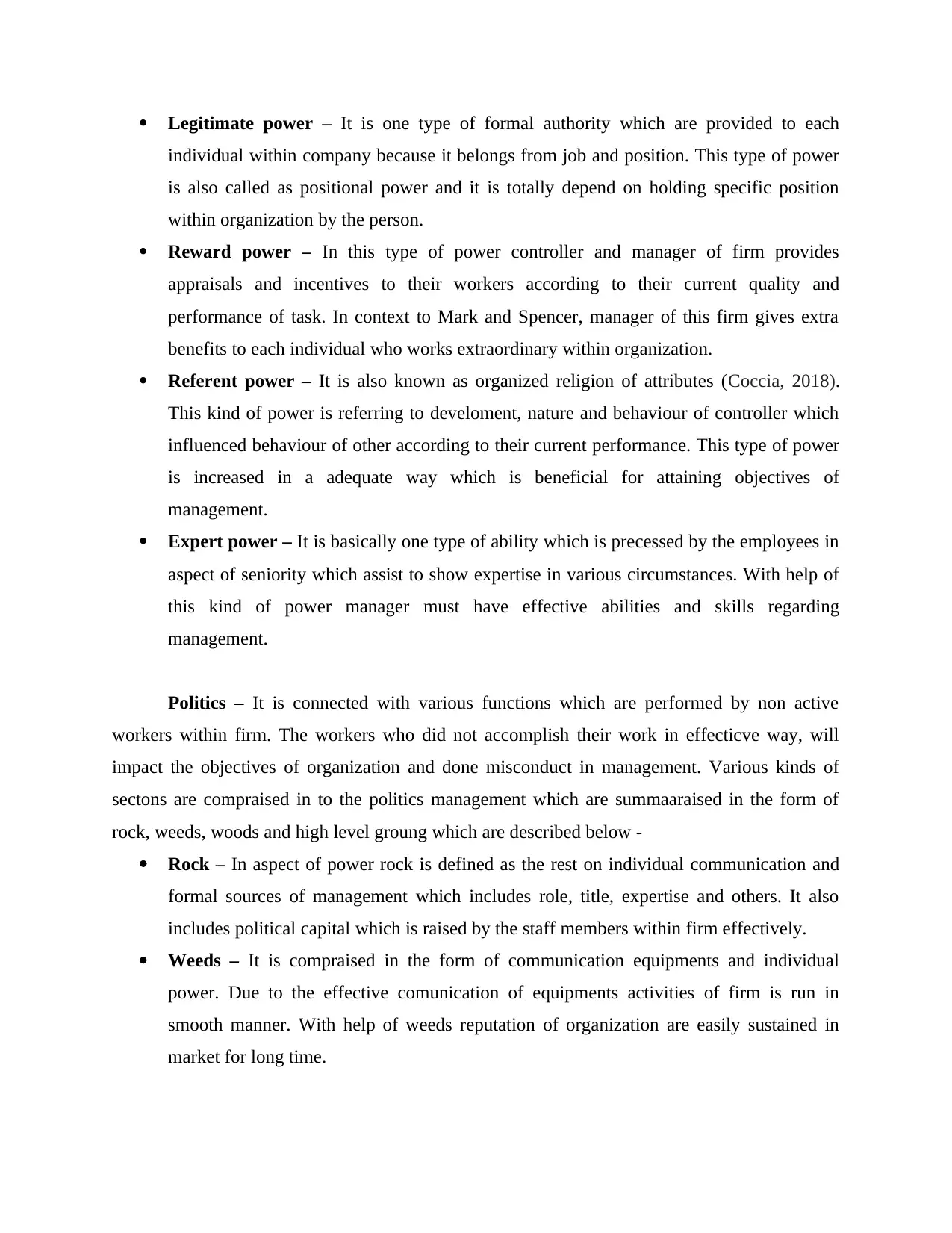
Legitimate power – It is one type of formal authority which are provided to each
individual within company because it belongs from job and position. This type of power
is also called as positional power and it is totally depend on holding specific position
within organization by the person.
Reward power – In this type of power controller and manager of firm provides
appraisals and incentives to their workers according to their current quality and
performance of task. In context to Mark and Spencer, manager of this firm gives extra
benefits to each individual who works extraordinary within organization.
Referent power – It is also known as organized religion of attributes (Coccia, 2018).
This kind of power is referring to develoment, nature and behaviour of controller which
influenced behaviour of other according to their current performance. This type of power
is increased in a adequate way which is beneficial for attaining objectives of
management.
Expert power – It is basically one type of ability which is precessed by the employees in
aspect of seniority which assist to show expertise in various circumstances. With help of
this kind of power manager must have effective abilities and skills regarding
management.
Politics – It is connected with various functions which are performed by non active
workers within firm. The workers who did not accomplish their work in effecticve way, will
impact the objectives of organization and done misconduct in management. Various kinds of
sectons are compraised in to the politics management which are summaaraised in the form of
rock, weeds, woods and high level groung which are described below -
Rock – In aspect of power rock is defined as the rest on individual communication and
formal sources of management which includes role, title, expertise and others. It also
includes political capital which is raised by the staff members within firm effectively.
Weeds – It is compraised in the form of communication equipments and individual
power. Due to the effective comunication of equipments activities of firm is run in
smooth manner. With help of weeds reputation of organization are easily sustained in
market for long time.
individual within company because it belongs from job and position. This type of power
is also called as positional power and it is totally depend on holding specific position
within organization by the person.
Reward power – In this type of power controller and manager of firm provides
appraisals and incentives to their workers according to their current quality and
performance of task. In context to Mark and Spencer, manager of this firm gives extra
benefits to each individual who works extraordinary within organization.
Referent power – It is also known as organized religion of attributes (Coccia, 2018).
This kind of power is referring to develoment, nature and behaviour of controller which
influenced behaviour of other according to their current performance. This type of power
is increased in a adequate way which is beneficial for attaining objectives of
management.
Expert power – It is basically one type of ability which is precessed by the employees in
aspect of seniority which assist to show expertise in various circumstances. With help of
this kind of power manager must have effective abilities and skills regarding
management.
Politics – It is connected with various functions which are performed by non active
workers within firm. The workers who did not accomplish their work in effecticve way, will
impact the objectives of organization and done misconduct in management. Various kinds of
sectons are compraised in to the politics management which are summaaraised in the form of
rock, weeds, woods and high level groung which are described below -
Rock – In aspect of power rock is defined as the rest on individual communication and
formal sources of management which includes role, title, expertise and others. It also
includes political capital which is raised by the staff members within firm effectively.
Weeds – It is compraised in the form of communication equipments and individual
power. Due to the effective comunication of equipments activities of firm is run in
smooth manner. With help of weeds reputation of organization are easily sustained in
market for long time.
Paraphrase This Document
Need a fresh take? Get an instant paraphrase of this document with our AI Paraphraser
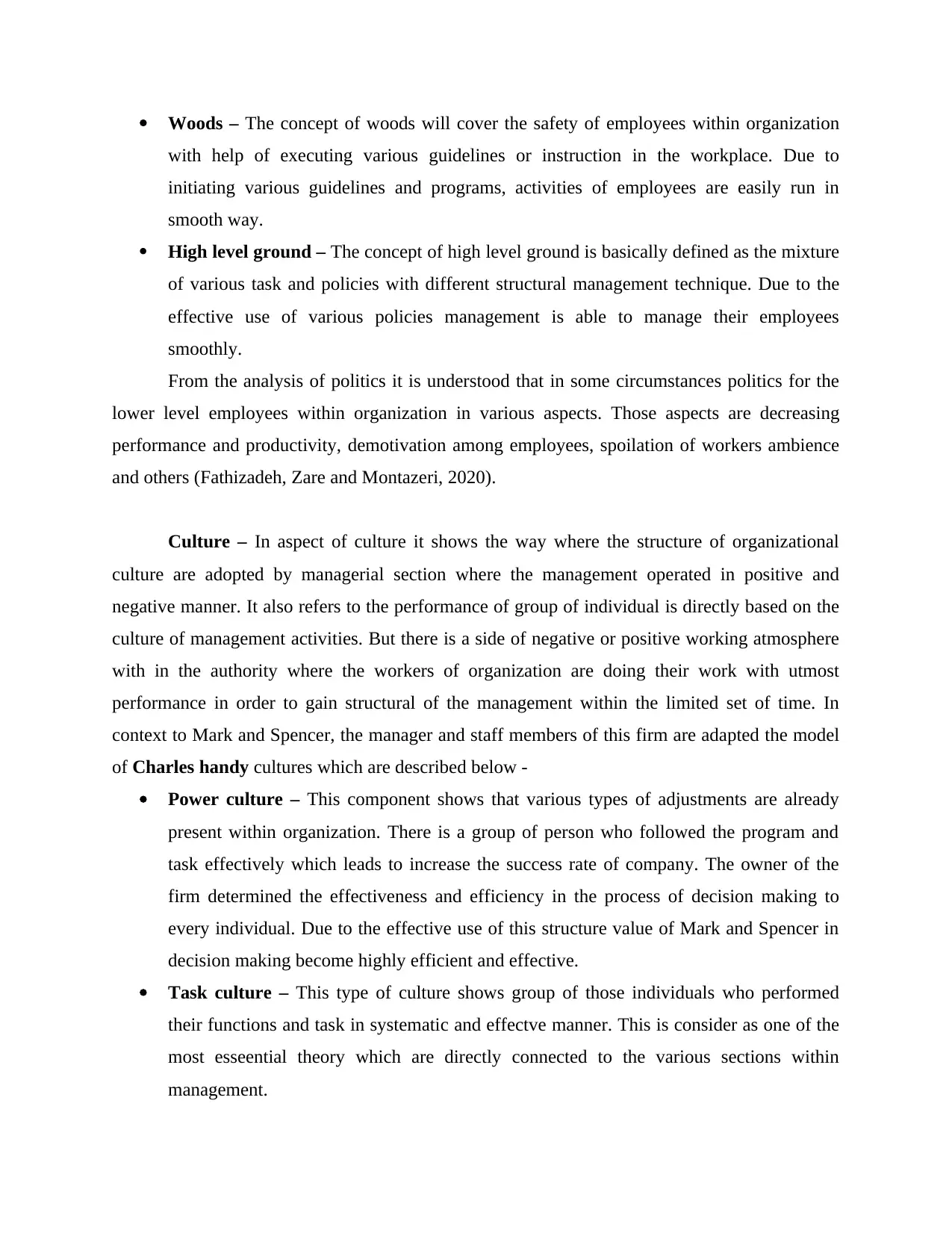
Woods – The concept of woods will cover the safety of employees within organization
with help of executing various guidelines or instruction in the workplace. Due to
initiating various guidelines and programs, activities of employees are easily run in
smooth way.
High level ground – The concept of high level ground is basically defined as the mixture
of various task and policies with different structural management technique. Due to the
effective use of various policies management is able to manage their employees
smoothly.
From the analysis of politics it is understood that in some circumstances politics for the
lower level employees within organization in various aspects. Those aspects are decreasing
performance and productivity, demotivation among employees, spoilation of workers ambience
and others (Fathizadeh, Zare and Montazeri, 2020).
Culture – In aspect of culture it shows the way where the structure of organizational
culture are adopted by managerial section where the management operated in positive and
negative manner. It also refers to the performance of group of individual is directly based on the
culture of management activities. But there is a side of negative or positive working atmosphere
with in the authority where the workers of organization are doing their work with utmost
performance in order to gain structural of the management within the limited set of time. In
context to Mark and Spencer, the manager and staff members of this firm are adapted the model
of Charles handy cultures which are described below -
Power culture – This component shows that various types of adjustments are already
present within organization. There is a group of person who followed the program and
task effectively which leads to increase the success rate of company. The owner of the
firm determined the effectiveness and efficiency in the process of decision making to
every individual. Due to the effective use of this structure value of Mark and Spencer in
decision making become highly efficient and effective.
Task culture – This type of culture shows group of those individuals who performed
their functions and task in systematic and effectve manner. This is consider as one of the
most esseential theory which are directly connected to the various sections within
management.
with help of executing various guidelines or instruction in the workplace. Due to
initiating various guidelines and programs, activities of employees are easily run in
smooth way.
High level ground – The concept of high level ground is basically defined as the mixture
of various task and policies with different structural management technique. Due to the
effective use of various policies management is able to manage their employees
smoothly.
From the analysis of politics it is understood that in some circumstances politics for the
lower level employees within organization in various aspects. Those aspects are decreasing
performance and productivity, demotivation among employees, spoilation of workers ambience
and others (Fathizadeh, Zare and Montazeri, 2020).
Culture – In aspect of culture it shows the way where the structure of organizational
culture are adopted by managerial section where the management operated in positive and
negative manner. It also refers to the performance of group of individual is directly based on the
culture of management activities. But there is a side of negative or positive working atmosphere
with in the authority where the workers of organization are doing their work with utmost
performance in order to gain structural of the management within the limited set of time. In
context to Mark and Spencer, the manager and staff members of this firm are adapted the model
of Charles handy cultures which are described below -
Power culture – This component shows that various types of adjustments are already
present within organization. There is a group of person who followed the program and
task effectively which leads to increase the success rate of company. The owner of the
firm determined the effectiveness and efficiency in the process of decision making to
every individual. Due to the effective use of this structure value of Mark and Spencer in
decision making become highly efficient and effective.
Task culture – This type of culture shows group of those individuals who performed
their functions and task in systematic and effectve manner. This is consider as one of the
most esseential theory which are directly connected to the various sections within
management.
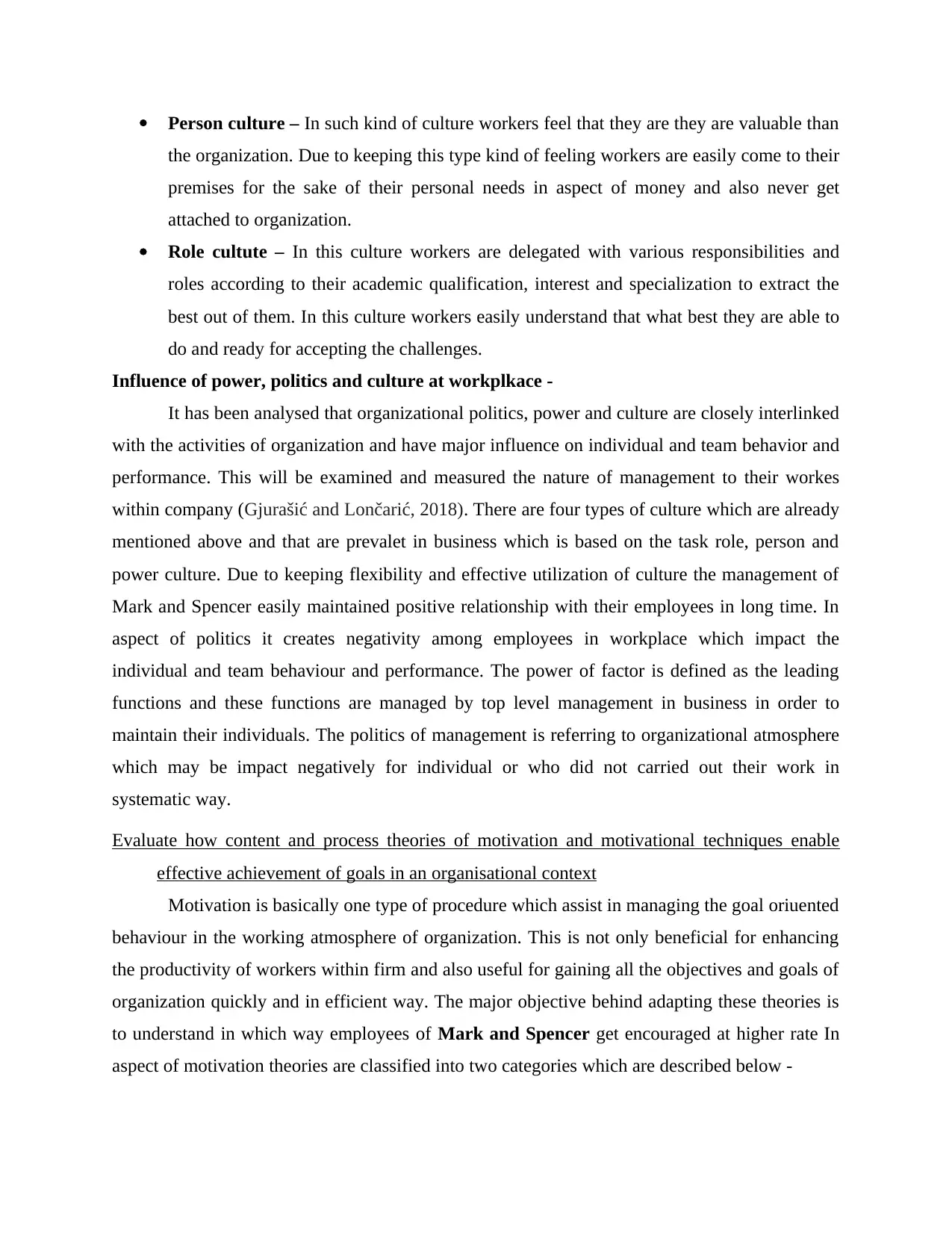
Person culture – In such kind of culture workers feel that they are they are valuable than
the organization. Due to keeping this type kind of feeling workers are easily come to their
premises for the sake of their personal needs in aspect of money and also never get
attached to organization.
Role cultute – In this culture workers are delegated with various responsibilities and
roles according to their academic qualification, interest and specialization to extract the
best out of them. In this culture workers easily understand that what best they are able to
do and ready for accepting the challenges.
Influence of power, politics and culture at workplkace -
It has been analysed that organizational politics, power and culture are closely interlinked
with the activities of organization and have major influence on individual and team behavior and
performance. This will be examined and measured the nature of management to their workes
within company (Gjurašić and Lončarić, 2018). There are four types of culture which are already
mentioned above and that are prevalet in business which is based on the task role, person and
power culture. Due to keeping flexibility and effective utilization of culture the management of
Mark and Spencer easily maintained positive relationship with their employees in long time. In
aspect of politics it creates negativity among employees in workplace which impact the
individual and team behaviour and performance. The power of factor is defined as the leading
functions and these functions are managed by top level management in business in order to
maintain their individuals. The politics of management is referring to organizational atmosphere
which may be impact negatively for individual or who did not carried out their work in
systematic way.
Evaluate how content and process theories of motivation and motivational techniques enable
effective achievement of goals in an organisational context
Motivation is basically one type of procedure which assist in managing the goal oriuented
behaviour in the working atmosphere of organization. This is not only beneficial for enhancing
the productivity of workers within firm and also useful for gaining all the objectives and goals of
organization quickly and in efficient way. The major objective behind adapting these theories is
to understand in which way employees of Mark and Spencer get encouraged at higher rate In
aspect of motivation theories are classified into two categories which are described below -
the organization. Due to keeping this type kind of feeling workers are easily come to their
premises for the sake of their personal needs in aspect of money and also never get
attached to organization.
Role cultute – In this culture workers are delegated with various responsibilities and
roles according to their academic qualification, interest and specialization to extract the
best out of them. In this culture workers easily understand that what best they are able to
do and ready for accepting the challenges.
Influence of power, politics and culture at workplkace -
It has been analysed that organizational politics, power and culture are closely interlinked
with the activities of organization and have major influence on individual and team behavior and
performance. This will be examined and measured the nature of management to their workes
within company (Gjurašić and Lončarić, 2018). There are four types of culture which are already
mentioned above and that are prevalet in business which is based on the task role, person and
power culture. Due to keeping flexibility and effective utilization of culture the management of
Mark and Spencer easily maintained positive relationship with their employees in long time. In
aspect of politics it creates negativity among employees in workplace which impact the
individual and team behaviour and performance. The power of factor is defined as the leading
functions and these functions are managed by top level management in business in order to
maintain their individuals. The politics of management is referring to organizational atmosphere
which may be impact negatively for individual or who did not carried out their work in
systematic way.
Evaluate how content and process theories of motivation and motivational techniques enable
effective achievement of goals in an organisational context
Motivation is basically one type of procedure which assist in managing the goal oriuented
behaviour in the working atmosphere of organization. This is not only beneficial for enhancing
the productivity of workers within firm and also useful for gaining all the objectives and goals of
organization quickly and in efficient way. The major objective behind adapting these theories is
to understand in which way employees of Mark and Spencer get encouraged at higher rate In
aspect of motivation theories are classified into two categories which are described below -
⊘ This is a preview!⊘
Do you want full access?
Subscribe today to unlock all pages.

Trusted by 1+ million students worldwide
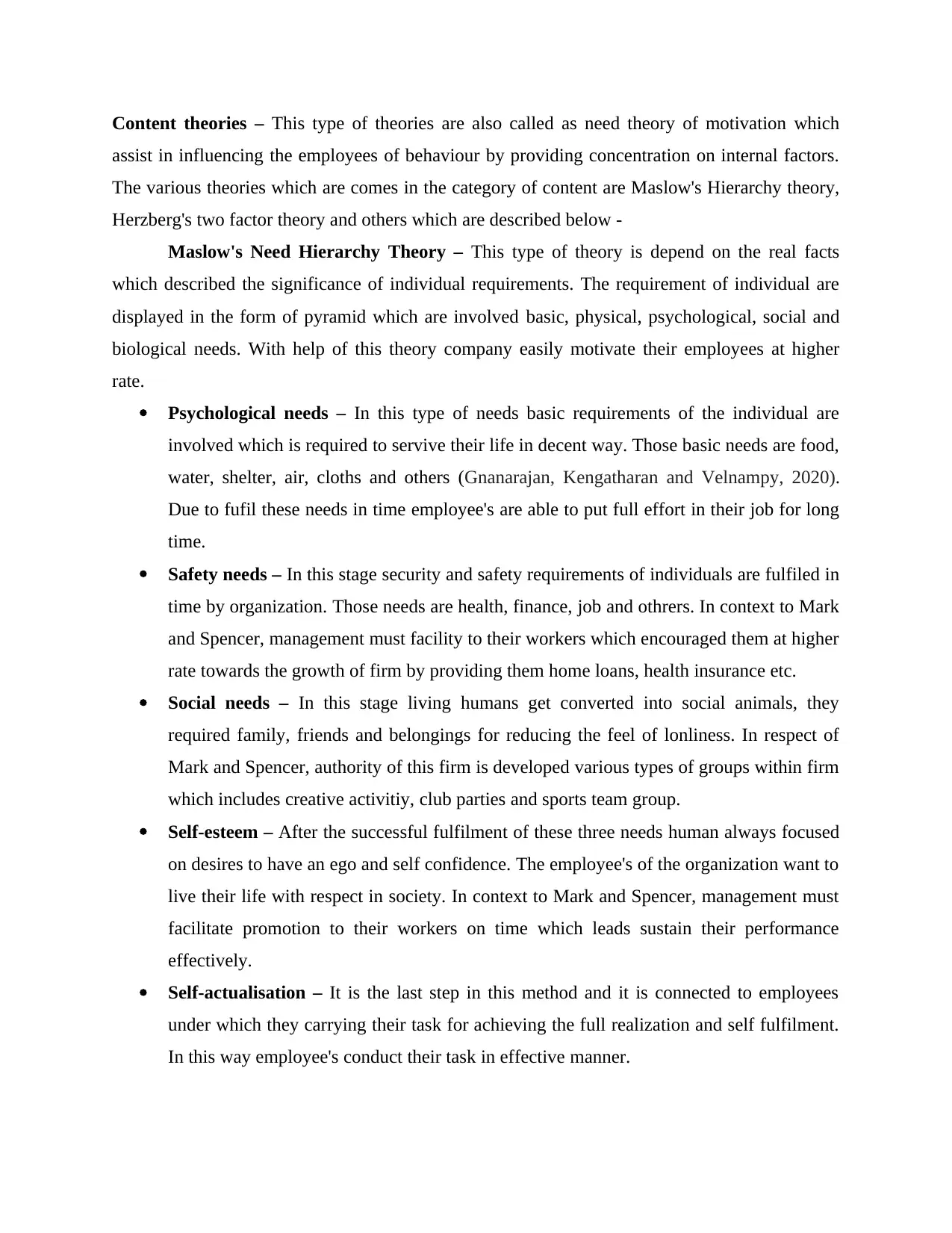
Content theories – This type of theories are also called as need theory of motivation which
assist in influencing the employees of behaviour by providing concentration on internal factors.
The various theories which are comes in the category of content are Maslow's Hierarchy theory,
Herzberg's two factor theory and others which are described below -
Maslow's Need Hierarchy Theory – This type of theory is depend on the real facts
which described the significance of individual requirements. The requirement of individual are
displayed in the form of pyramid which are involved basic, physical, psychological, social and
biological needs. With help of this theory company easily motivate their employees at higher
rate.
Psychological needs – In this type of needs basic requirements of the individual are
involved which is required to servive their life in decent way. Those basic needs are food,
water, shelter, air, cloths and others (Gnanarajan, Kengatharan and Velnampy, 2020).
Due to fufil these needs in time employee's are able to put full effort in their job for long
time.
Safety needs – In this stage security and safety requirements of individuals are fulfiled in
time by organization. Those needs are health, finance, job and othrers. In context to Mark
and Spencer, management must facility to their workers which encouraged them at higher
rate towards the growth of firm by providing them home loans, health insurance etc.
Social needs – In this stage living humans get converted into social animals, they
required family, friends and belongings for reducing the feel of lonliness. In respect of
Mark and Spencer, authority of this firm is developed various types of groups within firm
which includes creative activitiy, club parties and sports team group.
Self-esteem – After the successful fulfilment of these three needs human always focused
on desires to have an ego and self confidence. The employee's of the organization want to
live their life with respect in society. In context to Mark and Spencer, management must
facilitate promotion to their workers on time which leads sustain their performance
effectively.
Self-actualisation – It is the last step in this method and it is connected to employees
under which they carrying their task for achieving the full realization and self fulfilment.
In this way employee's conduct their task in effective manner.
assist in influencing the employees of behaviour by providing concentration on internal factors.
The various theories which are comes in the category of content are Maslow's Hierarchy theory,
Herzberg's two factor theory and others which are described below -
Maslow's Need Hierarchy Theory – This type of theory is depend on the real facts
which described the significance of individual requirements. The requirement of individual are
displayed in the form of pyramid which are involved basic, physical, psychological, social and
biological needs. With help of this theory company easily motivate their employees at higher
rate.
Psychological needs – In this type of needs basic requirements of the individual are
involved which is required to servive their life in decent way. Those basic needs are food,
water, shelter, air, cloths and others (Gnanarajan, Kengatharan and Velnampy, 2020).
Due to fufil these needs in time employee's are able to put full effort in their job for long
time.
Safety needs – In this stage security and safety requirements of individuals are fulfiled in
time by organization. Those needs are health, finance, job and othrers. In context to Mark
and Spencer, management must facility to their workers which encouraged them at higher
rate towards the growth of firm by providing them home loans, health insurance etc.
Social needs – In this stage living humans get converted into social animals, they
required family, friends and belongings for reducing the feel of lonliness. In respect of
Mark and Spencer, authority of this firm is developed various types of groups within firm
which includes creative activitiy, club parties and sports team group.
Self-esteem – After the successful fulfilment of these three needs human always focused
on desires to have an ego and self confidence. The employee's of the organization want to
live their life with respect in society. In context to Mark and Spencer, management must
facilitate promotion to their workers on time which leads sustain their performance
effectively.
Self-actualisation – It is the last step in this method and it is connected to employees
under which they carrying their task for achieving the full realization and self fulfilment.
In this way employee's conduct their task in effective manner.
Paraphrase This Document
Need a fresh take? Get an instant paraphrase of this document with our AI Paraphraser
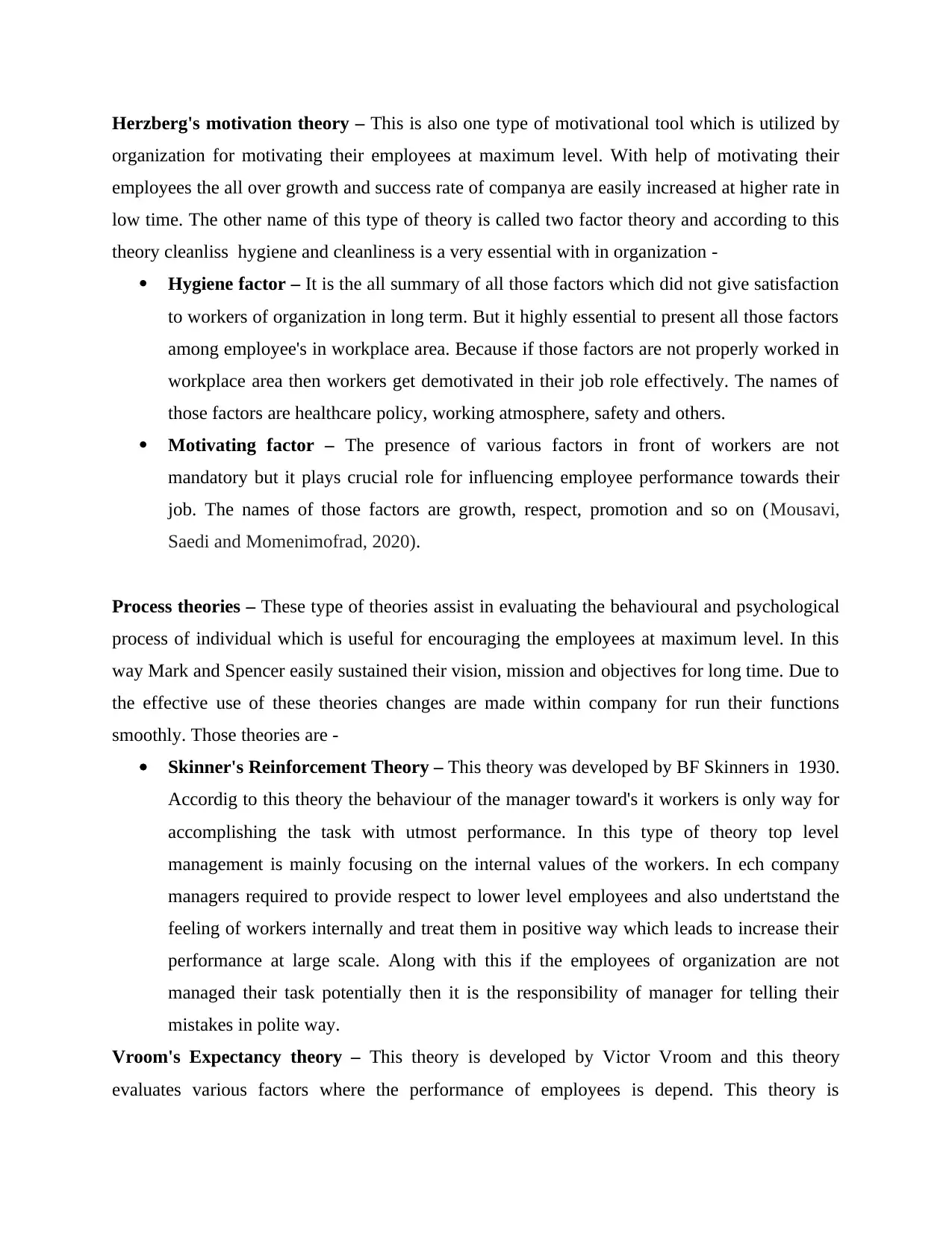
Herzberg's motivation theory – This is also one type of motivational tool which is utilized by
organization for motivating their employees at maximum level. With help of motivating their
employees the all over growth and success rate of companya are easily increased at higher rate in
low time. The other name of this type of theory is called two factor theory and according to this
theory cleanliss hygiene and cleanliness is a very essential with in organization -
Hygiene factor – It is the all summary of all those factors which did not give satisfaction
to workers of organization in long term. But it highly essential to present all those factors
among employee's in workplace area. Because if those factors are not properly worked in
workplace area then workers get demotivated in their job role effectively. The names of
those factors are healthcare policy, working atmosphere, safety and others.
Motivating factor – The presence of various factors in front of workers are not
mandatory but it plays crucial role for influencing employee performance towards their
job. The names of those factors are growth, respect, promotion and so on (Mousavi,
Saedi and Momenimofrad, 2020).
Process theories – These type of theories assist in evaluating the behavioural and psychological
process of individual which is useful for encouraging the employees at maximum level. In this
way Mark and Spencer easily sustained their vision, mission and objectives for long time. Due to
the effective use of these theories changes are made within company for run their functions
smoothly. Those theories are -
Skinner's Reinforcement Theory – This theory was developed by BF Skinners in 1930.
Accordig to this theory the behaviour of the manager toward's it workers is only way for
accomplishing the task with utmost performance. In this type of theory top level
management is mainly focusing on the internal values of the workers. In ech company
managers required to provide respect to lower level employees and also undertstand the
feeling of workers internally and treat them in positive way which leads to increase their
performance at large scale. Along with this if the employees of organization are not
managed their task potentially then it is the responsibility of manager for telling their
mistakes in polite way.
Vroom's Expectancy theory – This theory is developed by Victor Vroom and this theory
evaluates various factors where the performance of employees is depend. This theory is
organization for motivating their employees at maximum level. With help of motivating their
employees the all over growth and success rate of companya are easily increased at higher rate in
low time. The other name of this type of theory is called two factor theory and according to this
theory cleanliss hygiene and cleanliness is a very essential with in organization -
Hygiene factor – It is the all summary of all those factors which did not give satisfaction
to workers of organization in long term. But it highly essential to present all those factors
among employee's in workplace area. Because if those factors are not properly worked in
workplace area then workers get demotivated in their job role effectively. The names of
those factors are healthcare policy, working atmosphere, safety and others.
Motivating factor – The presence of various factors in front of workers are not
mandatory but it plays crucial role for influencing employee performance towards their
job. The names of those factors are growth, respect, promotion and so on (Mousavi,
Saedi and Momenimofrad, 2020).
Process theories – These type of theories assist in evaluating the behavioural and psychological
process of individual which is useful for encouraging the employees at maximum level. In this
way Mark and Spencer easily sustained their vision, mission and objectives for long time. Due to
the effective use of these theories changes are made within company for run their functions
smoothly. Those theories are -
Skinner's Reinforcement Theory – This theory was developed by BF Skinners in 1930.
Accordig to this theory the behaviour of the manager toward's it workers is only way for
accomplishing the task with utmost performance. In this type of theory top level
management is mainly focusing on the internal values of the workers. In ech company
managers required to provide respect to lower level employees and also undertstand the
feeling of workers internally and treat them in positive way which leads to increase their
performance at large scale. Along with this if the employees of organization are not
managed their task potentially then it is the responsibility of manager for telling their
mistakes in polite way.
Vroom's Expectancy theory – This theory is developed by Victor Vroom and this theory
evaluates various factors where the performance of employees is depend. This theory is

compraises of personality, knowledge, skills and ability. The factors which are involved in this
theory are -
Valance – If the management of organization wants to encourage their workers then they
need to realize requirements effectively. For doing this managent required consider
various reward systems promotions, time off and others.
Expectancy – In this type of factors managers of the organization get coordination with
company expectation to their workers. For fulfilling the expectations management must
provide advance training to their employees (Murtezaj and Ahmeti, 2021).
Instrumentality – In this factor managers of the company effectively communicate all
the target to their employees and promise them to give rewards for developing feeling of
motivation within them.
Employee motivation techniques -
The techniques of motivation is defined as the extrinsic and intrinsic influences that lends
in the job satisfaction meaningful contribution to performance and functions. The various types
of motivation techniques which is utilized by the employers of Mark and Spencer for motivating
their employees are -
Share profits to increase productivity – When organization recognized the programs of
profit sharing, it provides a significant pride to each individual. Due to providing benefits
to employees they become loyal towards company in long term.
Radient positivity – Building strong positive culture in workplace is a common and
effective tool for motivating the individuals at higher rate. In respect of Mark and
Spencer required to organize various activities which includes music session, game
activities with their subordinates effectively. It leads to increase the motivation level of
employers at higher rate.
Explain what makes an effective team as opposed to an ineffective team
Employees of organization is highly consider as major part of organization and also for
organization's success at maximum level. Because for the success of organization contribution
and participation of employees are highly important. The management of Mark and Spencer has
developed the strong teams within company which is beneficial for using all types of resources
in optimized manner and brings the talent which put efforts in the company success.
theory are -
Valance – If the management of organization wants to encourage their workers then they
need to realize requirements effectively. For doing this managent required consider
various reward systems promotions, time off and others.
Expectancy – In this type of factors managers of the organization get coordination with
company expectation to their workers. For fulfilling the expectations management must
provide advance training to their employees (Murtezaj and Ahmeti, 2021).
Instrumentality – In this factor managers of the company effectively communicate all
the target to their employees and promise them to give rewards for developing feeling of
motivation within them.
Employee motivation techniques -
The techniques of motivation is defined as the extrinsic and intrinsic influences that lends
in the job satisfaction meaningful contribution to performance and functions. The various types
of motivation techniques which is utilized by the employers of Mark and Spencer for motivating
their employees are -
Share profits to increase productivity – When organization recognized the programs of
profit sharing, it provides a significant pride to each individual. Due to providing benefits
to employees they become loyal towards company in long term.
Radient positivity – Building strong positive culture in workplace is a common and
effective tool for motivating the individuals at higher rate. In respect of Mark and
Spencer required to organize various activities which includes music session, game
activities with their subordinates effectively. It leads to increase the motivation level of
employers at higher rate.
Explain what makes an effective team as opposed to an ineffective team
Employees of organization is highly consider as major part of organization and also for
organization's success at maximum level. Because for the success of organization contribution
and participation of employees are highly important. The management of Mark and Spencer has
developed the strong teams within company which is beneficial for using all types of resources
in optimized manner and brings the talent which put efforts in the company success.
⊘ This is a preview!⊘
Do you want full access?
Subscribe today to unlock all pages.

Trusted by 1+ million students worldwide
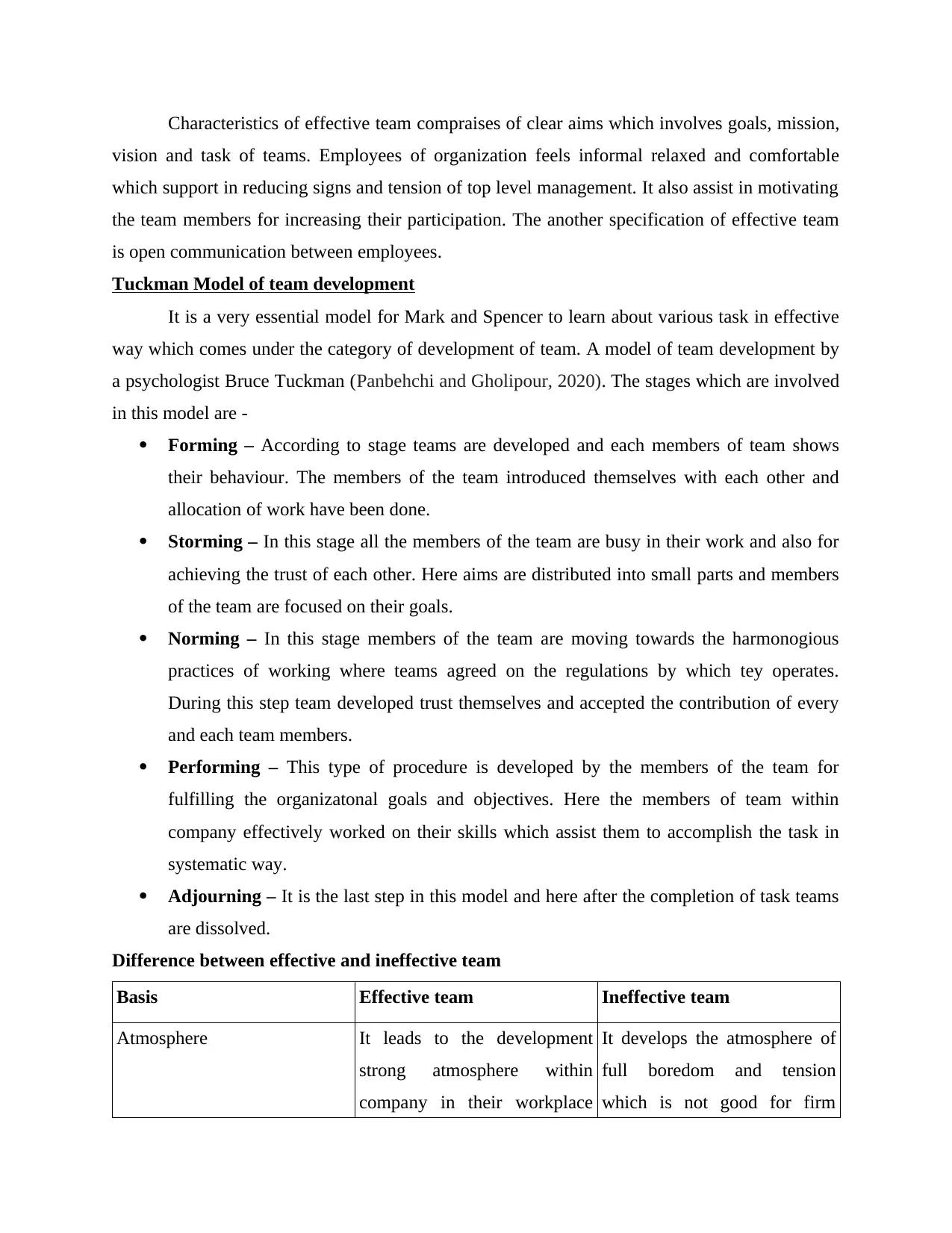
Characteristics of effective team compraises of clear aims which involves goals, mission,
vision and task of teams. Employees of organization feels informal relaxed and comfortable
which support in reducing signs and tension of top level management. It also assist in motivating
the team members for increasing their participation. The another specification of effective team
is open communication between employees.
Tuckman Model of team development
It is a very essential model for Mark and Spencer to learn about various task in effective
way which comes under the category of development of team. A model of team development by
a psychologist Bruce Tuckman (Panbehchi and Gholipour, 2020). The stages which are involved
in this model are -
Forming – According to stage teams are developed and each members of team shows
their behaviour. The members of the team introduced themselves with each other and
allocation of work have been done.
Storming – In this stage all the members of the team are busy in their work and also for
achieving the trust of each other. Here aims are distributed into small parts and members
of the team are focused on their goals.
Norming – In this stage members of the team are moving towards the harmonogious
practices of working where teams agreed on the regulations by which tey operates.
During this step team developed trust themselves and accepted the contribution of every
and each team members.
Performing – This type of procedure is developed by the members of the team for
fulfilling the organizatonal goals and objectives. Here the members of team within
company effectively worked on their skills which assist them to accomplish the task in
systematic way.
Adjourning – It is the last step in this model and here after the completion of task teams
are dissolved.
Difference between effective and ineffective team
Basis Effective team Ineffective team
Atmosphere It leads to the development
strong atmosphere within
company in their workplace
It develops the atmosphere of
full boredom and tension
which is not good for firm
vision and task of teams. Employees of organization feels informal relaxed and comfortable
which support in reducing signs and tension of top level management. It also assist in motivating
the team members for increasing their participation. The another specification of effective team
is open communication between employees.
Tuckman Model of team development
It is a very essential model for Mark and Spencer to learn about various task in effective
way which comes under the category of development of team. A model of team development by
a psychologist Bruce Tuckman (Panbehchi and Gholipour, 2020). The stages which are involved
in this model are -
Forming – According to stage teams are developed and each members of team shows
their behaviour. The members of the team introduced themselves with each other and
allocation of work have been done.
Storming – In this stage all the members of the team are busy in their work and also for
achieving the trust of each other. Here aims are distributed into small parts and members
of the team are focused on their goals.
Norming – In this stage members of the team are moving towards the harmonogious
practices of working where teams agreed on the regulations by which tey operates.
During this step team developed trust themselves and accepted the contribution of every
and each team members.
Performing – This type of procedure is developed by the members of the team for
fulfilling the organizatonal goals and objectives. Here the members of team within
company effectively worked on their skills which assist them to accomplish the task in
systematic way.
Adjourning – It is the last step in this model and here after the completion of task teams
are dissolved.
Difference between effective and ineffective team
Basis Effective team Ineffective team
Atmosphere It leads to the development
strong atmosphere within
company in their workplace
It develops the atmosphere of
full boredom and tension
which is not good for firm
Paraphrase This Document
Need a fresh take? Get an instant paraphrase of this document with our AI Paraphraser
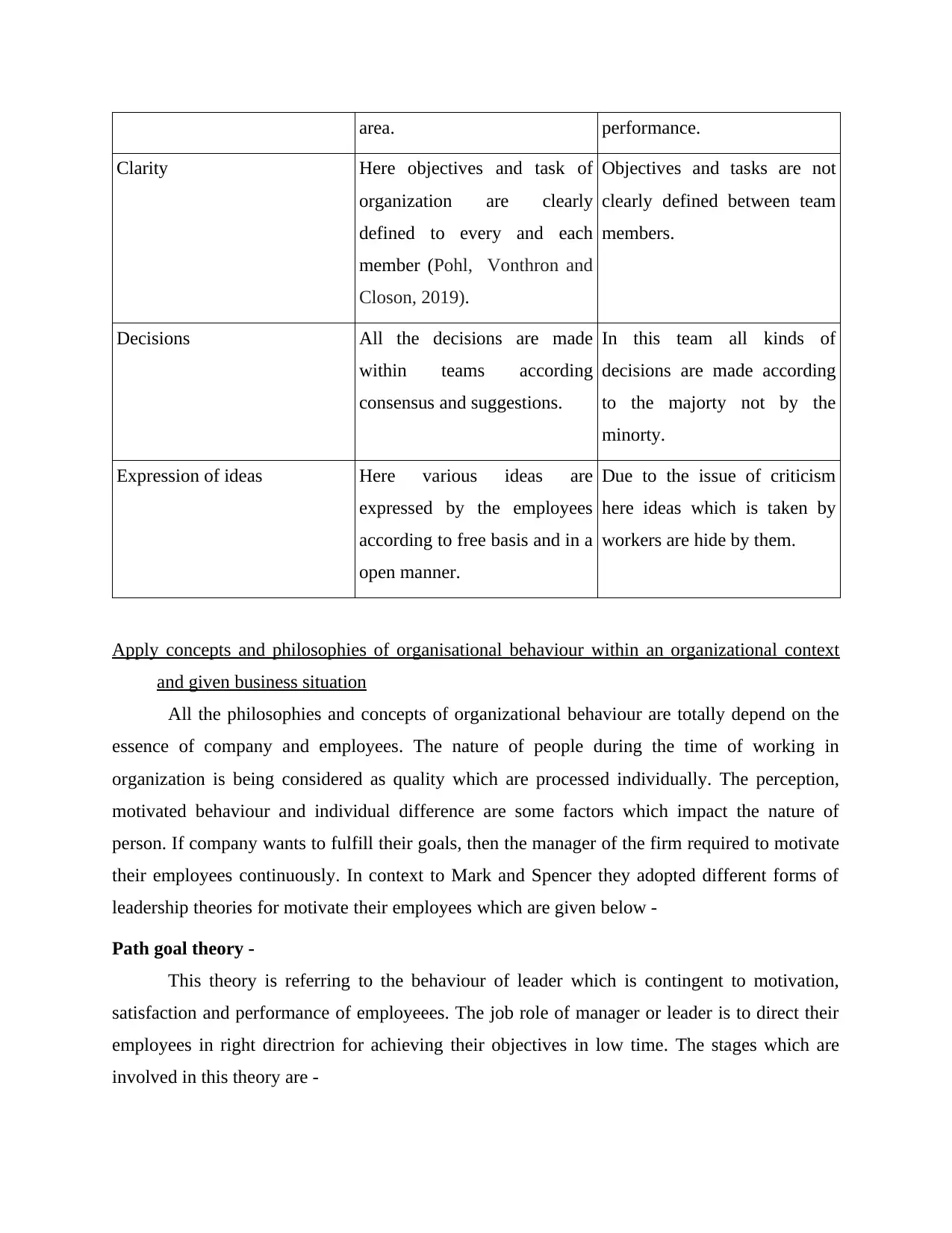
area. performance.
Clarity Here objectives and task of
organization are clearly
defined to every and each
member (Pohl, Vonthron and
Closon, 2019).
Objectives and tasks are not
clearly defined between team
members.
Decisions All the decisions are made
within teams according
consensus and suggestions.
In this team all kinds of
decisions are made according
to the majorty not by the
minorty.
Expression of ideas Here various ideas are
expressed by the employees
according to free basis and in a
open manner.
Due to the issue of criticism
here ideas which is taken by
workers are hide by them.
Apply concepts and philosophies of organisational behaviour within an organizational context
and given business situation
All the philosophies and concepts of organizational behaviour are totally depend on the
essence of company and employees. The nature of people during the time of working in
organization is being considered as quality which are processed individually. The perception,
motivated behaviour and individual difference are some factors which impact the nature of
person. If company wants to fulfill their goals, then the manager of the firm required to motivate
their employees continuously. In context to Mark and Spencer they adopted different forms of
leadership theories for motivate their employees which are given below -
Path goal theory -
This theory is referring to the behaviour of leader which is contingent to motivation,
satisfaction and performance of employeees. The job role of manager or leader is to direct their
employees in right directrion for achieving their objectives in low time. The stages which are
involved in this theory are -
Clarity Here objectives and task of
organization are clearly
defined to every and each
member (Pohl, Vonthron and
Closon, 2019).
Objectives and tasks are not
clearly defined between team
members.
Decisions All the decisions are made
within teams according
consensus and suggestions.
In this team all kinds of
decisions are made according
to the majorty not by the
minorty.
Expression of ideas Here various ideas are
expressed by the employees
according to free basis and in a
open manner.
Due to the issue of criticism
here ideas which is taken by
workers are hide by them.
Apply concepts and philosophies of organisational behaviour within an organizational context
and given business situation
All the philosophies and concepts of organizational behaviour are totally depend on the
essence of company and employees. The nature of people during the time of working in
organization is being considered as quality which are processed individually. The perception,
motivated behaviour and individual difference are some factors which impact the nature of
person. If company wants to fulfill their goals, then the manager of the firm required to motivate
their employees continuously. In context to Mark and Spencer they adopted different forms of
leadership theories for motivate their employees which are given below -
Path goal theory -
This theory is referring to the behaviour of leader which is contingent to motivation,
satisfaction and performance of employeees. The job role of manager or leader is to direct their
employees in right directrion for achieving their objectives in low time. The stages which are
involved in this theory are -

Directive leadership – In this kind of leadership leader permit their followers to
understand that what expectation have from them. Here leader also provides right
direction and shedules task according to the expectation.
Supportive leadership – This type of leadership is very friendly and approachable. Here
leader always focus on the welfare to their team members and treat them in equal manner.
Participative leadership – This type of leaders always take suggestion with the
followers and permits participation in the procedure of decision making effectively.
Achievement oriented leadership – Here leader sets challenging tasks and expects
followers to perform the same (Prabhu, 2020). Encouraging followers and showing
confidence in their abilities is essential for leaders.
Contigency theory -
According to this theory organizational behaviour is utilized to predict, asses and
managing the workers behaviour so that organization easily understand in which way individuals
are effectively motivated. There are various situational factors which effect the study of
organizational behaviour and relates prediction of employee's behaviour. The theory of
contigency described that there is no certain type of leadership styles which is suitable for all
types of situations. An individual is effective in one situation and ineffective in another situation.
For enhance the efficiency of leader it is necessary for him that he must analyse all the situations
effectively then after that he must adopt the pattern of leadership. In respect of Mark and
Spencer, the theories of leadership impact the efficiency of leader. Different leaders with
different leadership styles will react to the factors in different ways.
understand that what expectation have from them. Here leader also provides right
direction and shedules task according to the expectation.
Supportive leadership – This type of leadership is very friendly and approachable. Here
leader always focus on the welfare to their team members and treat them in equal manner.
Participative leadership – This type of leaders always take suggestion with the
followers and permits participation in the procedure of decision making effectively.
Achievement oriented leadership – Here leader sets challenging tasks and expects
followers to perform the same (Prabhu, 2020). Encouraging followers and showing
confidence in their abilities is essential for leaders.
Contigency theory -
According to this theory organizational behaviour is utilized to predict, asses and
managing the workers behaviour so that organization easily understand in which way individuals
are effectively motivated. There are various situational factors which effect the study of
organizational behaviour and relates prediction of employee's behaviour. The theory of
contigency described that there is no certain type of leadership styles which is suitable for all
types of situations. An individual is effective in one situation and ineffective in another situation.
For enhance the efficiency of leader it is necessary for him that he must analyse all the situations
effectively then after that he must adopt the pattern of leadership. In respect of Mark and
Spencer, the theories of leadership impact the efficiency of leader. Different leaders with
different leadership styles will react to the factors in different ways.
⊘ This is a preview!⊘
Do you want full access?
Subscribe today to unlock all pages.

Trusted by 1+ million students worldwide
1 out of 15
Related Documents
Your All-in-One AI-Powered Toolkit for Academic Success.
+13062052269
info@desklib.com
Available 24*7 on WhatsApp / Email
![[object Object]](/_next/static/media/star-bottom.7253800d.svg)
Unlock your academic potential
Copyright © 2020–2025 A2Z Services. All Rights Reserved. Developed and managed by ZUCOL.


